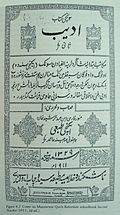lingvo.wikisort.org - Language
Southern Uzbek, also known as Afghan Uzbek, is the southern variant of the Uzbek language and an official language of Afghanistan where it is based and has up to 6 million speakers. It uses the Perso-Arabic writing system in contrast to the language variant of Uzbekistan.
| Southern Uzbek | |
|---|---|
| اوزبیکچه, اوزبیکی, اوزبیک تورکچه | |
 | |
| Native to | Afghanistan |
| Ethnicity | Uzbeks |
Native speakers | 6 million (2021)[1] |
Language family | |
Early forms | |
Writing system | Perso-Arabic |
| Official status | |
Official language in | |
Recognised minority language in |
|
| Regulated by | Afghan Ministry of Education |
| Language codes | |
| ISO 639-3 | uzs |
| Glottolog | sout2699 |
| Linguasphere | 44-AAB-da, db |
Southern Uzbek is intelligible with the Northern Uzbek spoken in Uzbekistan to a certain degree. However it has differences in grammar and also many more loan words from Afghan Persian (in which many Southern Uzbek speakers are proficient).[3]
Southern Uzbek Alphabet

Southern Uzbek is written using the Perso-Arabic writing system called Arab Yozuv ("Arab Script"). Although it contains the same 32 letters which are used in Persian, it pronounces many of them in a different way.
See also
References
- Southern Uzbek at Ethnologue (18th ed., 2015) (subscription required)
- Scott Newton (20 November 2014). Law and the Making of the Soviet World: The Red Demiurge. Routledge. p. 232. ISBN 978-1-317-92978-9.
- "Uzbek, Southern".
External links
- Online Dictionary
Southern Uzbek language test of Wikipedia at Wikimedia Incubator
На других языках
- [en] Southern Uzbek language
[ru] Южный диалект узбекского языка
Ю́жный диале́кт узбе́кского языка́, также известный как южноузбе́кский язы́к, Афга́нский диале́кт узбе́кского языка́ — один из крупнейших диалектов узбекского языка, относящийся к карлукской группе тюркских языков. Основан на узбекской письменности с арабской графикой. Является одним из официальных языков в некоторых северных вилаятах (провинциях) Исламской Республики Афганистан, а также фактически третьим официальным языком страны после дари и пушту. В основном распространён в Афганистане, а также в соседних Пакистане и Иране.Текст в блоке "Читать" взят с сайта "Википедия" и доступен по лицензии Creative Commons Attribution-ShareAlike; в отдельных случаях могут действовать дополнительные условия.
Другой контент может иметь иную лицензию. Перед использованием материалов сайта WikiSort.org внимательно изучите правила лицензирования конкретных элементов наполнения сайта.
Другой контент может иметь иную лицензию. Перед использованием материалов сайта WikiSort.org внимательно изучите правила лицензирования конкретных элементов наполнения сайта.
2019-2025
WikiSort.org - проект по пересортировке и дополнению контента Википедии
WikiSort.org - проект по пересортировке и дополнению контента Википедии